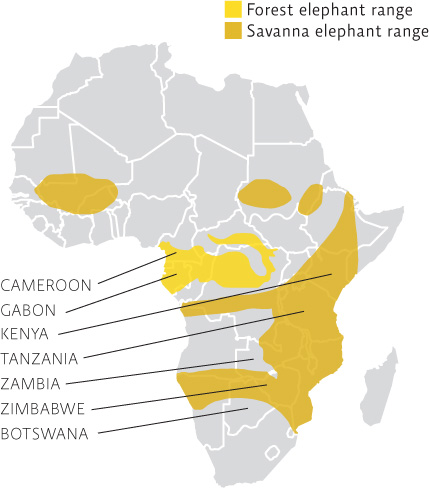Chapter Introduction
238
CHAPTER 13
PRESERVING BIODIVERSITY
A FOREST WITHOUT ELEPHANTS
Can we save one of Earth’s iconic species?

CORE MESSAGE
Today, many species on Earth are in danger of becoming extinct, predominately due to human impact. Protection plans can focus on individual species or entire ecosystems; both methods have proven successful. A combination of national and international efforts is helping address biodiversity loss. Individuals can also help by making consumer choices that support sustainable use of biodiversity rather than actions that exploit and endanger species.
AFTER READING THIS CHAPTER, YOU SHOULD BE ABLE TO ANSWER THE FOLLOWING GUIDING QUESTIONS
1 What events or actions threaten species today, and what conservation status designations are used to identify the threat level? How does the loss or reduction of a species impact its ecosystem?
2 How do single-species conservation programs compare to ecosystem-based approaches?
239
3 How does conservation genetics contribute to the conservation of species?
4 What legal protections do threatened species have in the United States and internationally?
5 In what ways are local communities important to the success of conservation efforts? What role do consumers play in protecting biodiversity?
240
Deep in the African rain forest, an elephant has just been killed. Her corpse is found by park rangers; the body has been poked through with spears, the cheeks and trunk have been eaten away by scavengers. the rest was taken by the poachers who killed her: the tail sliced off to be made into bracelets of black elephant hair, which are popular with tourists, the eyes to be sold to traditional Chinese medicine shops, where their purported medicinal powers fetch a high price. the biggest prize, though— indeed, the whole reason for the killing—were the tusks, two gleaming protrusions of pure ivory that have been hacked off with an ax and are now making their way, by looping, circuitous routes, to jewelry shops in Manhattan and Beijing.
Elsewhere in the forest, the victim’s herd is grieving. Elephants exhibit complex behaviors and are known for both their elaborate communication networks and their uncannily human mourning rituals. Even when they are miles apart, the members of a family maintain regular contact, communicating with sounds too low for human ears. When a family member dies, they process past the body—marching in slow, single file. Occasionally one elephant or another will place its foot over the heart of the deceased or prod the lifeless body with its trunk. They often remain with the deceased for days and may even cover the body with dirt and branches.
Elephant poaching in Africa is at its highest level in decades. A 2014 report on the illegal ivory trade revealed that in 2011 alone, authorities estimate that 25,000 African elephants were killed and 50 metric tons (55 U.S. tons) of ivory were seized—more than in any previous year. Half of that was seized in 14 large-scale (500-kilogram [1,100-pound] or larger) ivory shipments. Poaching numbers omit after 2011, but the amount of ivory confiscated increased; in 2013, more than 55 metric tons (62 U.S. tons) were seized. “Evidence is steadily mounting,” says Tom Milliken, an elephant expert with Wildlife Conservation Society (WCS), that “African elephants are facing their most serious crisis since international commercial trade in ivory was first prohibited [in 1989].”

In some ways, the reasons for this uptick are obvious. Rising wealth and a growing market for elephant ivory in China (blocks made of ivory bearing a family’s crest or signature are a popular status symbol throughout the country) and other nations are being abetted by a dramatic increase in road building in Africa. (Growing populations and rising consumption around the world have necessitated more and more resource extraction from previously untouched lands.)
“African elephants are facing their most serious crisis since international commercial trade in ivory was first prohibited.” —Tom Milliken.
But the plight of forest elephants, and the saga of those racing to save them, is also part of a much larger, more complicated story—laced with grave dangers, daunting odds, and heroic efforts. It’s a story in which the world’s biodiversity—and thus life as we know it—hangs in the balance.
241